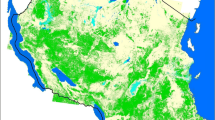Abstract
The contribution of Korean forests to carbon sequestration for anthropogenic carbon emissions was evaluated. In addition, monitoring of carbon species released from forest fires was conducted. Despite a high carbon uptake by Korean forests, a tremendous increase in fossil fuel burning resulted in a small contribution by forests to carbon removal. The removal efficiency had a 5–31% range with an average of 12% during the period 1973–2002. In 2000, the amount of carbon released from burned trees corresponded to 1.6% of carbon uptake by forests. The distribution of surface CO concentration (ppb) derived from MOPITT (Measurement of Pollution in the Troposphere) showed high CO levels over the East/Japan Sea on April 10, 2000 when the largest forest fires occurred along the east coast of Korea. Trajectory analysis and ground CO measurements also indicated that CO levels over the East/Japan Sea were influenced by forest fires. This study suggests that continuous monitoring of carbon emissions from forest fires is needed for a more reliable estimate of carbon flux in the environment.
Similar content being viewed by others
References
Andreae, M. O.: 1991, ‘Biomass burning: Its history, use, and distribution and its impact on environmental quality and global climate’, in: J. S. Levine (ed.), Global Biomass Burning: Atmospheric, Climatic, and Biospheric Implications, The MIT Press, Massachusetts, USA.
Choi, S.-D. and Chang, Y.-S.: 2004, ‘Factors affecting the distribution of the rate of carbon uptake by forests in South Korea’, Environ. Sci. Technol. 38, 484–488.
Choi, S.-D. and Chang, Y.-S.: 2005, ‘Large increase in carbon emissions from forest fires after intensive reforestation’, in {preparation}.
Choi, S.-D., Lee, K. and Chang, Y.-S.: 2002, ‘Large uptake rate of atmospheric carbon dioxide by planted forest biomass in Korea’, Global Biogeochem. Cy. 16(4), 1089, doi:1010.1029/2002GB001914.
Chung, Y.-S.: 2003, ‘Satellite detection of forest fires in Korea and associated smoke plumes’, Int. J. Remote Sens. 24(1), 1–7.
Draxler, R. R. and Rolph, G. D.: 2004, ‘HYSPLIT (HYbrid Single-Particle Lagrangian Integrated Trajectory) Model access via NOAA ARL READY Website (http://www.arl.noaa.gov/ready/ hysplit4.html)’, NOAA Air Resources Laboratory. Silver Spring, USA.
Edwards, D.P., Lamarque, J.-F., Attie, J.-L., Emmons, L.K., Richter, A., Cammas, J.-P., Gille, J.C., Francis, G.L., Deeter, M.N., Warner, J., Ziskin, D.C., Lyjak, L.V., Drummond, J.R. and Burrows, J.P.: 2003, ‘Tropospheric ozone over the tropical Atlantic: A satellite perspective’, J. Geophys. Res. 108 (D8), 4237, doi:4210.1029/2002JD002927.
EEA (European Environment Agency): 2002, EMEP/CORINAIR Emission Inventory Guidebook, 3rd edition, Copenhagen, Denmark.
Falkowski, P., Scholes, R.J., Boyle, E., Canadell, J., Canfield, D., Elser, J., Gruber, N., Hibbard, K., Hogberg, P., Linder, S., Mackenzie, F.T., Moore, B.I., Pedersen, T., Rosenthal, Y., Seitzinger, S., Smetacek, V. and Steffen, W.: 2000, ‘The global carbon cycle: A test of our knowledge of earth as a system’, Science 290, 291–296.
IPCC (Intergovernmental Panel on Climate Change): 1996, ‘Revised 1996 IPCC Guidelines for National Greenhouse Gas Inventories: Workbook’, Geneva, Switzerland.
Kajii, Y., Kato, S., Streets, D. G., Tsai, N.Y., Shvidenko, A., Nilsson, S., McCallum, I., Minko, N.P., Abushenko, N., Altyntsev, D. and Khodzer, T.V.: 2002, ‘Boreal forest fires in Siberia in 1998: Estimation of area burned and emissions of pollutants by advanced very high resolution radiometer satellite data’, J. Geophys. Res. 107(D24), 4745, doi:4710.1029/2001JD001078.
Lamarque, J.-F., Edwards, D.P., Emmons, L.K., Gille, J.C., Wilhelmi, O., Gerbig, C., Prevedel, D., Deeter, M.N., Warner, J., Ziskin, D.C., Khattatov, B., Francis, G.L., Yudin, V., Ho, S., Mao, D., Chen, J. and Drummond, J.R.: 2003, ‘Identification of CO plumes from MOPITT data: Application to the August 2000 Idaho-Montana forest fires’, Geophys. Res. Lett. 30(13), 1688, doi:1610.1029/2003GL017503.
Lee, D., Yook, K.H., Lee, D., Kang, S., Kang, H., Lim J.H. and Lee, K.H.: 2002, ‘Changes in annual CO2 fluxes estimated from inventory data in South Korea’, Sci. China 45, 87–96.
Marland, G., Boden, T.A. and Andres, R.J.: 2003, ‘Global, regional, and national CO2 emissions. In trends: A compendium of data on global change’, Carbon Dioxide Information Analysis Center, Oak Ridge National Laboratory, Oak Ridge, USA.
Pochanart, P., Kato, S., Katsuno, T. and Akimoto, H.: 2004, ‘Eurasian continental background and regionally polluted levels of ozone and CO observed in northeast Asia’, Atmos. Environ. 38(9), 1325–1336.
Author information
Authors and Affiliations
Corresponding author
Rights and permissions
About this article
Cite this article
Choi, SD., Chang, YS. Evaluation of Carbon Uptake and Emissions by Forests in Korea During the Last Thirty Years (1973–2002). Environ Monit Assess 117, 99–107 (2006). https://doi.org/10.1007/s10661-006-7982-x
Received:
Accepted:
Issue Date:
DOI: https://doi.org/10.1007/s10661-006-7982-x



